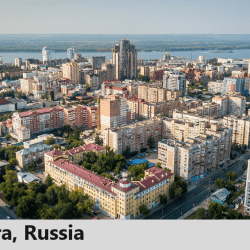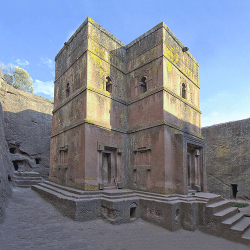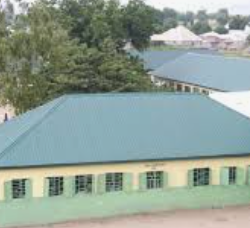The top 10 Russian cities according to population (2021 Census) are:
- Moscow
- Saint Petersburg
- Novosibirsk
- Yekaterinburg
- Kazan
- Nizhny Novgorod
- Chelyabinsk
- Krasnoyarsk
- Samara
- Ufa
| Rank | Town / City | Population |
| 1 | Moscow | 13,010,112 |
| 2 | Saint Petersburg | 5,601,911 |
| 3 | Novosibirsk | 1,633,595 |
| 4 | Yekaterinburg | 1,544,376 |
| 5 | Kazan | 1,308,660 |
| 6 | Nizhny Novgorod | 1,228,199 |
| 7 | Chelyabinsk | 1,189,525 |
| 8 | Krasnoyarsk | 1,187,771 |
| 9 | Samara | 1,173,299 |
| 10 | Ufa | 1,144,809 |
Moscow: The Heart of Russia
Moscow, the capital city, is the epicenter of Russian politics, culture, and religion. Founded in 1147, it has witnessed the rise of the Russian Empire, the Soviet Union, and modern Russia. Iconic landmarks such as the Kremlin, Red Square, and Saint Basil’s Cathedral symbolize the nation’s enduring history.
Economy and Modern Development
Moscow is the financial powerhouse of Russia, housing the headquarters of major companies, banks, and government institutions. The city’s metro system, one of the most beautiful in the world, represents both practicality and artistic grandeur.
Tourism Highlights in Moscow
Tourists flock to see the Bolshoi Theatre, the Tretyakov Gallery, and the vibrant Arbat Street.

Moscow is also a city of contrasts, where Soviet-era architecture stands beside futuristic skyscrapers like those in the Moscow International Business Center.
Saint Petersburg: The Cultural Capital
Historical Significance and Architecture
Founded by Peter the Great in 1703, Saint Petersburg was designed as Russia’s “window to Europe.” Its canals, baroque palaces, and neoclassical buildings earned it the nickname “Venice of the North.”
Arts, Museums, and Cultural Influence
The Hermitage Museum, one of the largest and oldest museums in the world, is a treasure trove of art and history. The Mariinsky Theatre continues to be a hub for opera and ballet.
Saint Petersburg Today
The city thrives as a cultural, educational, and industrial hub. It hosts international festivals and remains a favorite destination for both Russian and foreign visitors.
Novosibirsk: Siberia’s Largest City
Industrial and Scientific Center
Novosibirsk, located on the Ob River, is the third-largest city in Russia. Established in 1893 during the construction of the Trans-Siberian Railway, it quickly became a key industrial hub.
Education and Innovation
The city is home to Akademgorodok, a unique scientific and educational center founded during the Soviet era. Today, it continues to lead in technological research and innovation.
Lifestyle in Novosibirsk
Novosibirsk balances modern urban life with Siberian traditions. The city boasts cultural institutions such as the Novosibirsk Opera and Ballet Theatre, while its proximity to nature offers residents opportunities for outdoor activities year-round.
Yekaterinburg: Gateway to the Urals
Historical Role in Russian Politics
Yekaterinburg, the fourth-largest city in Russia, is often called the “gateway to the Urals.” Founded in 1723, it became an industrial hub during the 18th century. The city is also remembered as the site where the last Russian Tsar, Nicholas II, and his family were executed in 1918—a tragic event that shaped Russian history.
Economy and Business Hub
Today, Yekaterinburg is a major center for metallurgy, engineering, and finance. Its strategic location between Europe and Asia makes it an important trade and logistics hub.
Modern Attractions
The city boasts a thriving cultural scene with theaters, museums, and music festivals. The Church on the Blood, built on the site of the Romanovs’ execution, is a key landmark. Yekaterinburg is also known for its modern skyline, blending Soviet and contemporary architecture.
Kazan: Where Europe Meets Asia
Tatar Culture and Heritage
Kazan, the capital of Tatarstan, is one of Russia’s most multicultural cities. It is known for its rich Tatar heritage, blending Turkic and Slavic influences. The Kazan Kremlin, a UNESCO World Heritage Site, showcases a mix of Islamic and Russian Orthodox architecture.
Religious Harmony and Architecture
Kazan is often described as a city of religious harmony. The Kul Sharif Mosque and the Annunciation Cathedral stand side by side, symbolizing unity and tolerance.
Modern Kazan and Tourism
With its universities, sports arenas, and cultural institutions, Kazan is a vibrant city. It hosted several matches during the 2018 FIFA World Cup and continues to attract visitors from around the world.
Nizhny Novgorod: A Historic Trade Center
History of Commerce and Industry
Nizhny Novgorod, founded in 1221, flourished as a major trade and industrial hub. During the Soviet era, it was a closed city due to its military industries and was known as Gorky.
Cultural Life and Landmarks
The Nizhny Novgorod Kremlin and the Chkalov Staircase are iconic landmarks. The city also has a strong tradition in literature, being the birthplace of Maxim Gorky.
Nizhny Novgorod in Modern Russia
Today, the city remains a vital economic and cultural center, with growing industries in shipbuilding, IT, and machinery production.
Chelyabinsk: Industrial Powerhouse
Soviet Legacy and Industry
Chelyabinsk, located near the Ural Mountains, is famous for its heavy industry, particularly in metallurgy and machinery. During World War II, the city earned the nickname “Tankograd” for its production of military vehicles.
Culture and Local Life
Despite its industrial focus, Chelyabinsk has a vibrant cultural life, with theaters, museums, and music festivals. The 2013 meteor explosion near the city drew global attention.
Future Growth and Development
Chelyabinsk is working to balance its industrial heritage with modernization, investing in urban renewal projects and environmental improvements.
Krasnoyarsk: Siberia’s Natural Jewel
Geography and Natural Resources
Krasnoyarsk lies on the Yenisei River and is surrounded by stunning natural landscapes, including the Stolby Nature Reserve, known for its unique rock formations.
Cultural Identity of Krasnoyarsk
The city has a rich cultural scene, with annual festivals such as the Krasnoyarsk Biennale and the Siberian International Marathon.
Modern City Life
Krasnoyarsk combines industrial development with environmental beauty, making it one of the most attractive Siberian cities for both residents and visitors.
Samara: Volga River’s Economic Hub
History and Aerospace Legacy
Samara, located along the Volga River, played a critical role in the Soviet space program. The Samara Space Museum showcases its aerospace achievements.
Culture and Lifestyle
The city has a lively cultural scene with theaters, art galleries, and music venues. Samara’s riverfront promenade is a popular gathering place for locals.
Samara Today
Modern Samara is a hub for aerospace, engineering, and oil industries. It is also an emerging destination for tourism, especially during the summer months.
Ufa: Capital of Bashkortostan
Ethnic Diversity and Traditions
Ufa, the capital of Bashkortostan, is one of Russia’s most ethnically diverse cities. It blends Russian and Bashkir cultures, reflected in its festivals, food, and traditions.
Economic Role of Ufa
The city is a center for the oil refining and chemical industries. Its strategic location also supports strong trade connections.
Tourism and Modern Attractions
Ufa is known for its beautiful parks, the Salavat Yulaev Monument, and its growing reputation as a cultural hub in the Ural-Volga region.
Comparing Russia’s Major Cities
Cultural Differences
Moscow and Saint Petersburg dominate in global recognition, while cities like Kazan and Ufa highlight Russia’s cultural and ethnic diversity. Novosibirsk and Krasnoyarsk showcase Siberian resilience and innovation.
Economic Strengths
Moscow leads in finance and politics, Yekaterinburg in business and logistics, and Chelyabinsk in industry. Samara continues to hold an important aerospace legacy, while Kazan thrives in tourism and education.
Lifestyle and Demographics
Saint Petersburg is often viewed as more European, with a cosmopolitan flair, while cities like Nizhny Novgorod and Chelyabinsk retain stronger Soviet-era characteristics. Ufa and Kazan highlight multiculturalism, offering unique blends of traditions.
FAQs about Russian Cities
1. What is the largest city in Russia?
Moscow is the largest city, with over 13 million residents.
2. Which Russian city is known as the cultural capital?
Saint Petersburg is widely regarded as Russia’s cultural capital.
3. What is special about Kazan?
Kazan is famous for its Tatar culture and religious harmony, where mosques and Orthodox churches coexist.
4. Which city is considered the heart of Siberia?
Novosibirsk is often referred to as Siberia’s largest and most important city.
5. What makes Yekaterinburg significant?
It is both an industrial hub and a historic city, known as the place where the Romanov family met their tragic end.
6. Which Russian city is famous for space exploration?
Samara holds an important place in Russia’s space program and houses a dedicated space museum.









